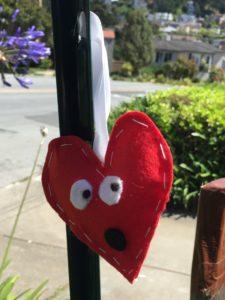 Did you ever wonder if there is a foolproof way to communicate with donors?
Did you ever wonder if there is a foolproof way to communicate with donors?
Actually, there is!
And it’s not about process.
It’s about another ‘p’ word.
Can you guess?
I’ll give you a hint.
It relates to the secret business your nonprofit is in.
You may think you’re in (arts, healthcare, human services, environment, social justice, animal rescue, education or whatever) but, fundamentally, your core business is something else. Something deeper.
Something that emanated from whoever founded your nonprofit.
Without this something, your nonprofit wouldn’t exist.
Have you figured it out?
PASSION!
If you think about it, you’ll know it’s the truth.
Passion is your nonprofit’s business. Your only business.
Without passion, you’ve got nothing.
Passion permeates your raison d’être.
Sure, it began with your founder’s passion. Today it’s your donors’ passions. And your board’s passions. And your own passions. Tomorrow it will be future generations’ passions.
What you and your donors are most passionate about may or may not change over time, so you must constantly be vigilant to assure you’re connecting to what speaks most to both your own and your supporters’ hearts at any point in time.
Always bring yourself, and your passions, to the table.
Then endeavor to connect with donors in a meaningful way.
The vitality of your appeal depends on shared passion.
Vitality is what brings your case for support to life.
For philanthropy to have vitality, always remember you’re speaking to one donor, and their passions, at a time.
You see, even the most heartfelt fundraising appeal from you is not going to yield results if you send it to someone who doesn’t much care about the problem you describe.
Just because it’s important to you, doesn’t mean it’s important to everyone.
This is why we make such a big deal about the concept of ‘donor-centered’ fundraising. If you haven’t read Penelope’ Burk’s groundbreaking book on the subject, I commend it to you. It totally changed the way I approach fundraising. In a good way.
You need to make a match between your passions and your donor’s passions.
Begin by getting in touch with your own passion.
I often say the heart of effective fundraising is passion, passion, passion.
- Get in touch with your passion
- Enact your passion
- Share your passion so your donor can enact theirs
If it’s just a job to you, and not a cause about which you’re particularly passionate, it can be difficult to write a compelling appeal.
Sure, you can include all the elements. A story. A visual. A caption. A clear problem. A realistic solution. The donor becoming the hero. A specific ask for a specific purpose. A ‘P.S.’ that shows compelling urgency.
But the appeal can still fall flat if there’s no passion beneath the prose.
Can’t you tell when people are faking it? When their heart isn’t really in it?
For development staff, this may mean:
Get out in the field to witness your program in action.
Sit down with program staff to learn about their work on a daily basis.
Schedule storytelling times where staff share sorrows and triumphs.
Have a ‘mission moment’ at board and committee meetings where select beneficiaries attend and share how they’ve been helped.
Sit down with yourself and write down all the reasons your organization’s work feels meaningful and vital to you. If your reason for feeling passionate has recently evolved or adapted to a crisis, be sure to note this shift.
For board members, this may mean:
All of the above.
Read scripture or other readings that inform your sense of moral/religious obligation.
Read up on the problem your organization addresses.
Talk to other board members about their experiences.
Do whatever it takes to get in touch with your passion for your cause.
Armed with passion for your cause, enact this passion by making your own gift.
It is my firm belief everyone working in development, and every board member, should make a philanthropic gift to the best of their ability.
This doesn’t mean staff must match what board members are giving. It does mean they should walk the talk.
If you feel giving to your nonprofit is out of the question because by virtue of working there you’re already ‘making a sacrifice,’ that’s a big chip on your shoulder that’s going to come across. If this is the case, it’s an issue that must be addressed first. You need to move folks (yourself included) from a place of distrust or hate to a place of love.
Which brings us to the critical importance of developing a culture of philanthropy (translated from the Greek to mean ‘love of humanity’). A culture in which everyone understands the mission doesn’t move forward without philanthropy – what Bob Payton of the Lily School of Philanthropy defined as “voluntary action for the public good.” It’s not about the amount of money. It’s about what’s in everyone’s hearts.
The art of fundraising is connecting with what’s in your own heart; then acting on it.
Share the opportunity to enact passion with others.
Whether you’re writing an appeal letter or asking for a gift in person, speak from your own passion.
Describe the problem – or opportunity – in a manner that makes it crystal clear how important it is for the donor to join you in this mission. Because, if they don’t, something incredibly bad will happen. Or something incredibly good won’t happen.
If you’re talking to the right audience — people who are passionate about the work you do – these folks will welcome your invitation to match your passion to theirs.
Use the information in your database to help you communicate the messages your donors most want to hear.
How do you figure this out?
Pay attention to what floats your donors’ boats. When your donor indicates to you in any way what may be important to them – listen up. For example:
They earmark their gift for a particular program. Cat donors don’t give to dog issues.
They open e-news or blog articles about particular areas of interest. Children’s donors don’t give as passionately to seniors’ issues.
They open social media posts about particular subjects. Rainforest donors don’t give as passionately to over-all climate change solutions.
They share information about particular subjects with others. Emergency relief donors don’t give as passionately to evergreen needs.
They attend certain events. Scholarship donors don’t give as passionately to teacher salaries.
They join informational conference calls. Pro-choice donors don’t care as passionately about other social justice issues.
They sign a petition on a particular topic. Veterans’ donors don’t give as passionately to other at-risk adults.
They give you anecdotal feedback, in person or online. You must record everything you learn about your donors in searchable fields in your database. That’s the way you’ll able to segment your donors by different criteria.
They respond to a survey. Especially if you asked them which programs they’re most passionate about, it’s important to document this so the information doesn’t get lost.
They tell a staff or board member something about their interests (which is why you need to debrief folks who interact with donors).
And so forth…
All of fundraising is a value-for-value exchange. Donors give money; you give back an intangible ‘feel good.’
The more you tap into your donor’s passion, the bigger the ‘feel good’ – and the bigger the gift.
Get inside your donor’s head and heart.
Here is some wisdom learned from donor-centered guru Penelope Burk, together with quotes from donors Burk surveyed (also here.):
1. LESS IS MORE
The less you tell your donor, the more likely they’ll absorb it.
You don’t necessarily need to be wordy to convey your message. Especially with email, research shows many folks stop reading anything below the scroll.
Think carefully about your SMIT (Single Most Important Thing you have to tell).
Don’t wait too long to get to it. Most fundraising appeals I read could stand to have their first several paragraphs eliminated. Look at last year’s appeal. Does the important messaging begin around the third or fourth paragraph? Start there. Eliminate the rest.
“Overall, the longer the letters and the more frequent the requests, the less likely I am to donate.”
2. SPECIFICS TRUMP GENERALITIES
The more specific the problem, the more likely donors will respond.
To which panhandler with a sign are you more likely to respond?
- HELP!
- NEED FOOD FOR MY 2 CHILDREN.
 People respond better when they can visualize how their gift will be used. This holds true in good times and bad. A generic crisis appeal asking the donor simply to send money to because “we’re in desperate times” will likely not do as well as a targeted appeal to give money for a specific purpose (e.g., underwrite staff salaries and benefits; respond to increased demand; innovate to offer new programming; fund an ‘Emergency Response Fund,’ etc.) Burk’s research reveals nonprofits’ insistence on unrestricted vs. restricted giving drives away donations.
People respond better when they can visualize how their gift will be used. This holds true in good times and bad. A generic crisis appeal asking the donor simply to send money to because “we’re in desperate times” will likely not do as well as a targeted appeal to give money for a specific purpose (e.g., underwrite staff salaries and benefits; respond to increased demand; innovate to offer new programming; fund an ‘Emergency Response Fund,’ etc.) Burk’s research reveals nonprofits’ insistence on unrestricted vs. restricted giving drives away donations.
“I don’t connect with appeals that ask me to “fix poverty” in my community. But if I were asked to provide interim housing for 10 women and their families so that they could leave abusive situations, I could get my head around that and I would feel my giving had more of an impact.”
3. CONTENT OVER PROCESS
Currency is your best currency.
I’ll never forget when I first heard Penelope Burk speak and she said (I’m paraphrasing): Donors don’t care about monthly newsletters. They’d rather hear from you when you have one piece of current news to share. Real news; not just articles you were forced to write because ‘send a monthly newsletter’ was on your plan. Or appeals you sent because ‘send bimonthly appeals’ was on your plan.
“They send out identical appeals week after week – pages and pages of stuff. It doesn’t inspire me to give; it desensitizes me to their pleas for help.”
4. BENEFITS TRUMP FEATURES
Show the donor the benefit they will receive.
It’s an old adage in marketing that you do best when you sell the benefit, not the feature. Too many fundraising communications are feature-dense.
We have this program… that service… these offices… those staff… oh, and this other related program… and….
This isn’t what the donor cares about. They want to know if there’s a specific problem they can solve with their gift. Benefits do not mean tangible gifts. The benefit donors find meaningful is the outcome philanthropy can create. And it’s two-fold: (1) the demonstrable impacts that can be created, and (2) the ‘feel good,’ meaning and purpose they’ll get in return.
“I’m more inclined to give when I can see a direct benefit.”
“I don’t need another umbrella, t-shirt or tote bag; I want my donation to go to the cause.”
5. PERSONAL APPROACH IS APPRECIATED
Go the extra mile.
It will be more than worth the investment of your time.
People are starved for love and human connection.
“There were two instances this year where I made gifts over and above what I had intended and they both involved personal contact from someone in the development office.”
6. TAP INTO DONOR MOTIVATIONS
Why a donor gives differs; learning about your donors’ motivations will pay off.
Common motivators are aspiring to fulfill a moral or religious obligation; desiring to honor or memorialize a loved one; wanting to pay back someone who helped the donor or a loved one; wanting to pay it forward to further a cause the donor or a loved one may someday benefit from, and family tradition.
“Our 17-year old son, Drew, died by suicide in 2014. Since his death, we donate to some meaningful causes every year in his memory, on his birthday. It is our way of continuing to give a birthday present to our son.”
“I was fortunate that the college I attended was tuition-free. I felt I owed a debt of gratitude for my education.”
“Dad used to let me call in the pledge to PBS when I was a kid. I thought that was a very grown up thing to do. For me, it planted the seed which has grown into a lifetime of philanthropy.”
7. POSITIVE FEEDBACK INSPIRES FUTURE GIFTS
Sadly, giving isn’t always its own reward.
When a kid cleans up their room without being asked, they need you to notice and tell them they did a good job.
When donors give, they need you to notice and tell them they delivered a specific, positive outcome.
“I didn’t receive any information at all after making a gift to a not-for-profit last year. I wonder what they did with the money and whether it helped.”
“An update on what they are accomplishing with the gifts that I and other donors have already made is actually more effective than another appeal. The updates themselves make you want to give again.”
Never forget the secret business your nonprofit is in.
You are in the passion business!
The best way to do this business is never to lose sight of this truth.
It boils down to a pretty simple formula:
- Connect with your own passion.
- Enact your own passion
- Endeavor to understand your donor’s passion.
- Invite your donor to act on their passion.
- Come from a place of love.
- Tackle one subject at a time.
- Be specific about how your donor can benefit.
- Give clear action choices; not too many.
- Sprinkle in some flattery to make your donor feel good about their passion.
- Give positive feedback when they enact their passion.
Do this again and again.
This is how you’ll stay in business – in good times and bad.
To your success!
Passion is Particularly Potent in Major Gifts Fundraising
 Individual major gift fundraising is both the most cost-effective form of fundraising and likely the quickest path to righting your ship when in the midst of a storm. Learn everything you need to know with my 4-volume Major Gifts Playbook. Each Companion Guide contains 20 – 60 pages and presents everything you need to know to kick start or rev up your major gifts program, and develop a system that produces exceptional results for your nonprofit. You won’t just find theory and background. You’ll find plenty to reinforce your learning and serve as handy tools this year and in the future. Practical tips. Worksheets. Exercises. Checklists. And more.
Individual major gift fundraising is both the most cost-effective form of fundraising and likely the quickest path to righting your ship when in the midst of a storm. Learn everything you need to know with my 4-volume Major Gifts Playbook. Each Companion Guide contains 20 – 60 pages and presents everything you need to know to kick start or rev up your major gifts program, and develop a system that produces exceptional results for your nonprofit. You won’t just find theory and background. You’ll find plenty to reinforce your learning and serve as handy tools this year and in the future. Practical tips. Worksheets. Exercises. Checklists. And more.
LIke all Clairification products, if you’re not satisfied for any reason this comes with a 30-day, no-questions-asked, 100% refund guarantee. And buy buying all four guides as a bundle, you get a really nice discount. Why not?





